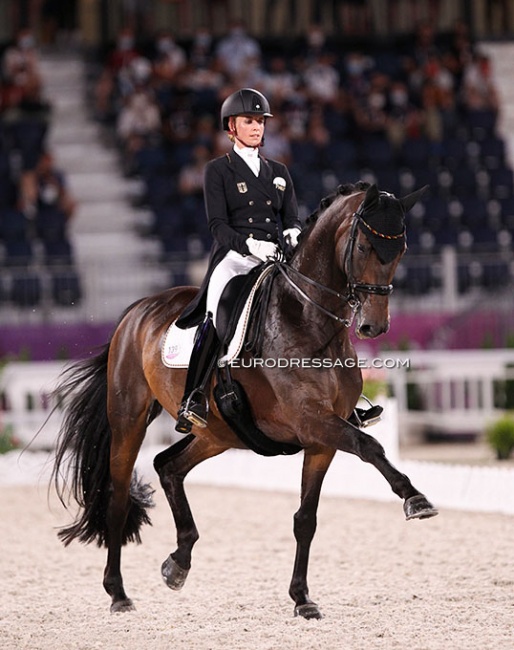
Germany's Jessica von Bredow-Werndl has set the standard and posted the high score of the evening after day 1 of the Grand Prix at the 2021 Olympic Games in Tokyo. Hosted at the magnificent Baji Koen equestrian centre, the 2021 Olympics are the culmination of elite dressage competition of the past five years.
A brand new format has been created for "Tokyo 2020" which is still the official name of these Games despite the one year postponement due to corona. Riders have been in Tokyo for more than a week giving their horses ample time to acclimatise to the hot and humid weather. The classes are all scheduled in the evening, starting at 17h00 JST time when the temperatures drop to a nice summery feel and with a breeze freshening up the hot air.
A surprise rain shower came down in the middle of the class last night and especially Belgian Larissa Paulius had to pilot her young Grand Prix horse Flambeau through these more challenging conditions. The big drops that came down, however, did little to reduce the temperature.
Heat Format Works Well
The Grand Prix serves as a qualification class for the Grand Prix Special as well as for the Grand Prix Kur. The 8 highest scoring teams in the Grand Prix move on to the Special and can compete for a team medal based on the scores achieved in the Special. The 2 highest scoring riders per Grand Prix heat out of 10 move on to the Kur to Music finals and can ride for the individual medal with their freestyle. In addition the 6 highest scoring riders from the Grand Prix, who were not in the top two of their heat, also qualify for the Kur.

f her late husband Greg in her glove. He died a year ago at age 39
from a heart attack
With two withdrawals before the vet check and three dropping out after the vet check, there was a lot of juggling to do by the FEI to draft a correct starters list. In the end the order of go was an exciting one with a good mix of the top riders and "lesser gods" in each heat; a much fairer system that counteracts the natural bias of judges, who automatically go up with their scores if all the best ones are starting at the end. This is a scientifically proven fact and not something I spin-doctored.
This preposterous system for a starting order now en vogue at Championships and CDI's was created by the FEI to fawn television stations; a concept that has become obsolete with online paid streaming services taking over the televised coverage
Mixed Messages
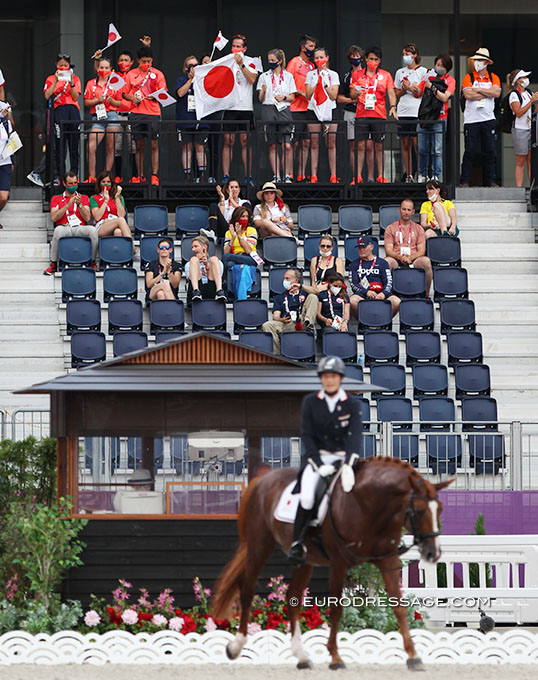
They carry a heavy burden on their shoulder deciding who earns eternal Olympic glory and a medal. But not only that, with their scores they decide the direction of competitive dressage and the standard of the sport. By high scoring riders/horses/tests they give a clear message of what they want to see and what gets rewarded. At the end of the first Grand Prix day many a spectator left the arena feeling that mixed messages have been sent across by them: what do they want? Lightness, harmony and an easy execution of the movements with light aids, or compression, power and arm wrestling in the saddle for the sake of spectacular movements and this wow-feeling in the arena?
I personally prefer the former and if you disagree with me, then please stop reading this article as the rest of what I write might not be to your liking and upset you. Sometimes ignorance is bliss.
I understand judging is a very difficult job and it's easy to be a keyboard crusader, but it's not too much to ask that a certain standard is upheld and carried consistently, especially at the Olympics as biggest and most important platform for the sport. Choose what you like! To use a food comparison, you also don't mix a plate of minimalistic umami spectacular sushi with an Italian spaghetti bolognaise. Both are great, but when it comes to fine dining, I again prefer the former.
Von Bredow-Werndl Sets the Standard
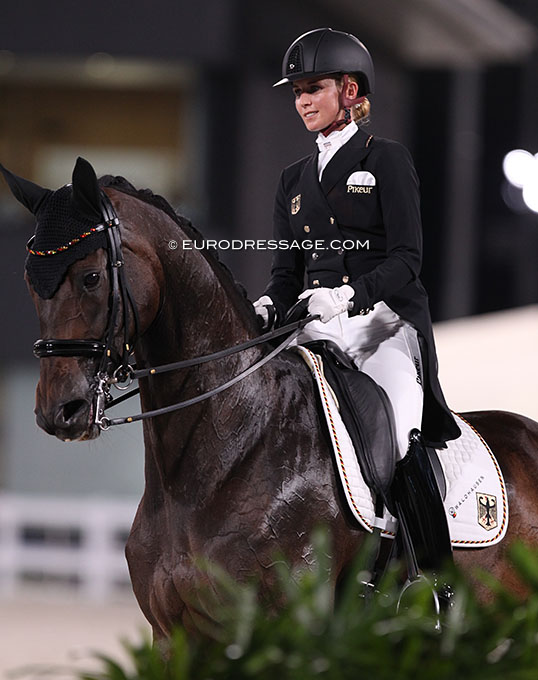
Von Bredow-Werndl has made it no secret this season that she has her eyes on the prize and gold is what she's going for. With Beatrice Burchler-Keller's Trakehner mare Dalera (by Easy Game x Handryk) she already beat Isabell Werth and Bella Rose once at the German Olympic team selection trial and her scores have been going through the roof, deservedly so as she and her tall, long backed mare are a pleasure to watch.
Also in Tokyo they continued on that great form, doing an exquisite halt at entry, riding expansive trot extensions, ground covering half passes. The rein back was a bit careful. The passage is lightfooted and the piaffe is on the spot and very rhythmical, even though to the core it is still too much on the forehand, but it looks easy-going and effortless. The extended walk was good, but again in the collection the mare loses the clarity of rhythm and ambles. The second piaffe-passage was so lovely and Jessica rode her horse with minimal aids, light in the bridle and with nice length in the neck. The pirouettes were auto pilot, the extended canter uphill. There was little to remark about the ride. They won their heat with the high score of the day, 84.379% and the judges were in unison.
Dufour and Bohemian Runner Up
Danish Cathrine Dufour and the Zinglersen family's 11-year old Westfalian gelding Bohemian (by Bordeaux x Samarant) became the winners of Heat 2 and produced the second highest score of the day, 81.056%.
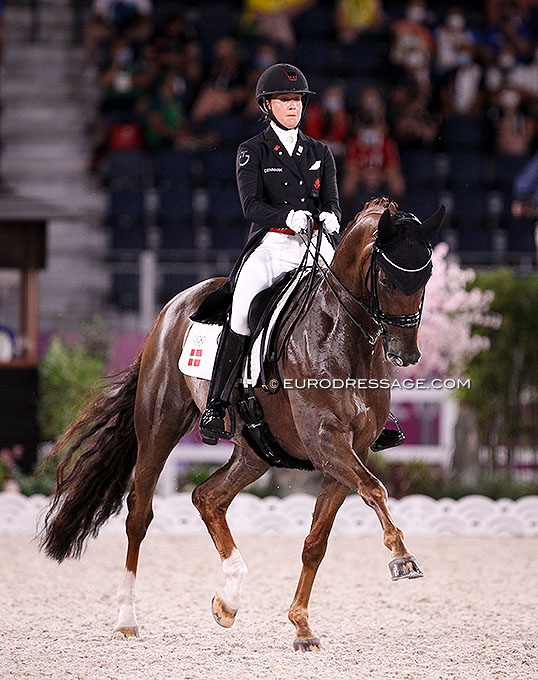
Dufour is such an elegant rider, who sits beautifully in the saddle, has a light contact with the bridle (sometimes a bit too light as the horse evades taking the bit), but it's a joy to see her manage the movements. The passage is soft and regular, the piaffe rhythmical although Bohemian does not truly lower the haunches and take the weight from behind. He also drops in the poll in piaffe. The rein back was good. The extended walk had two hooves overtrack and good rhythm. The right pirouette was a highlight. Overall, the working point with this horse is the back.. He needs to swing more through the back so the trot extensions, which do gain ground cover, are more elastic and overall there is not enough bending in the corners and turn. That being said, Dufour and Bohemian are true contenders for an individual medal and will give it their all.
The judges individual marks differed by 4% on this combination, the low score being 78.804 and the high score 82.391%
Orange is the New Black
The third highest score of the day was given to Dutch team anchor Edward Gal on his young, 9-year old Oldenburg gelding Total US (by Totilas x Sir Donnerhall). They were the second placed pair in Heat 2 behind Dufour.
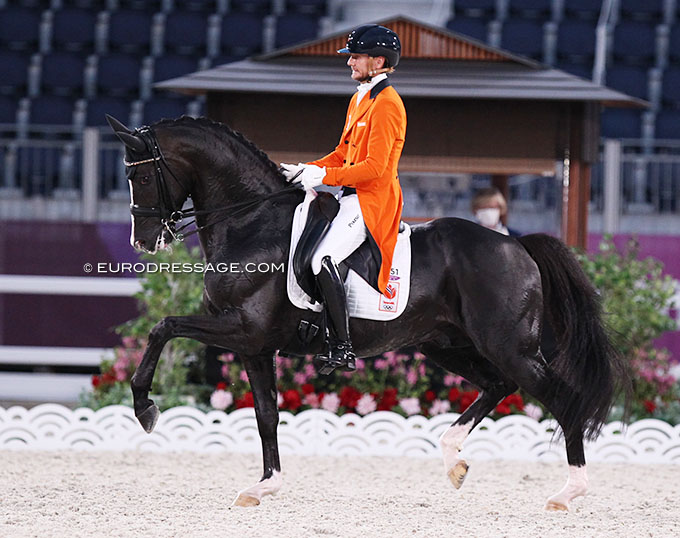
The judges love it though. They rewarded Gal 78.649%, but quite differed in opinion. Two were at 76%, two had him over 80%.
The Star of the Show
The revelation of the 2021 Olympic Games will without a doubt be German born American Sabine Schut-Kery. For those who don't read Eurodressage in detail, she might seem a new comer to elite sport, but for the ones following competition with eagle eyes, they know that we have already pointed out that Schut-Kery is all what classical dressage exemplifies!
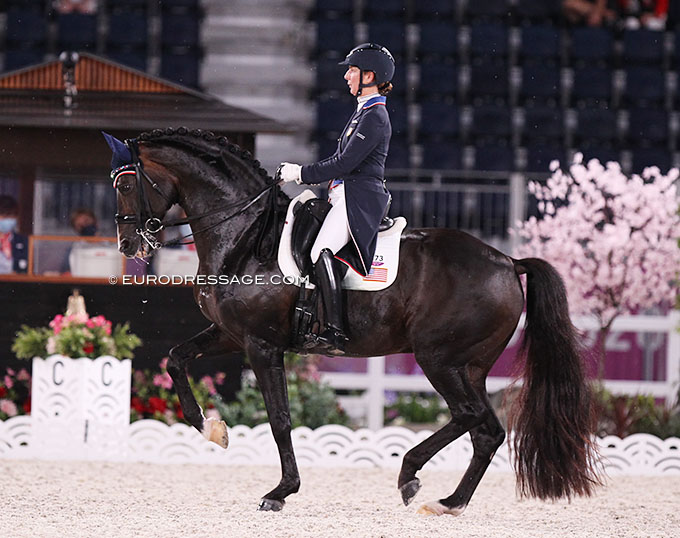
So yes, there were a few small niggles, but this ride was so beautiful, so elegant, light and correct ! Sanceo is accepting the bit, light in the contact, chews and foams the right way and is a properly gymnasticized horse. This is what dressage stands for. Bravo!
They scored 78.416% and placed second in Heat 3 behind Jessica von Bredow-Werndl. The judges' marks ranged from 77.391% to 79.239%.
Two Worlds
Heat 1 at the start of the competition presented an interesting duel between two popular dressage breeding stallions: the KWPN sire Everdale and the Oldenburg sire Dante Weltino. Both represented two different worlds of dressage. Again, do you like spaghetti or sushi?
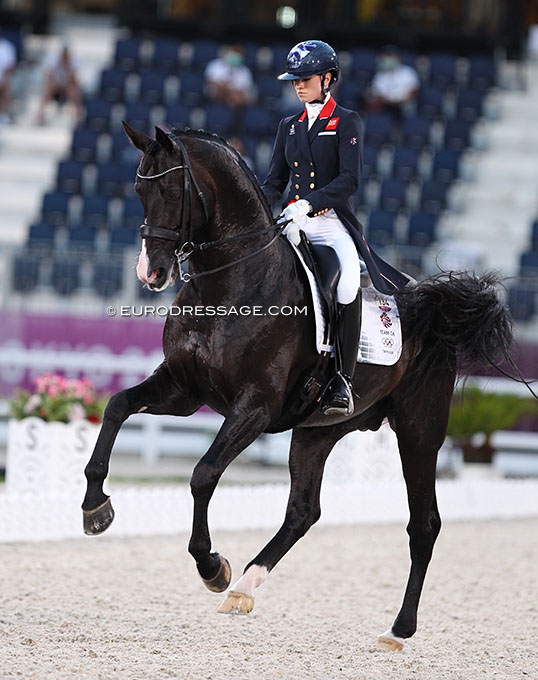
The petite Fry impresses with how she manages this powerful, testosterone driven black stallion and rides him with so much expression and ground cover through all the movements. That it is not an easy task is quite visible, as the horse is compressed and tight in the neck and has his tail swooshing like a helicopter rotor during the 6-minute ride. It would be nice to see more length in the neck and a more relaxed frame, even though this can be hard to achieve in an electric competition environment; but that is the goal of dressage. The trot extensions were big, the passage had much spring, the piaffes are on the spot and in rhythm, the one tempi changes huge and uphill, but overall Everdale does not lower the croup and flex those hocks to take more weight behind. It is visible in piaffe, in the extended canter, and also in the pirouettes which were a bit big and flat. The zig zag was a highlight with sweeping half passes from left to right. They scored 77.096% to win heat 1.
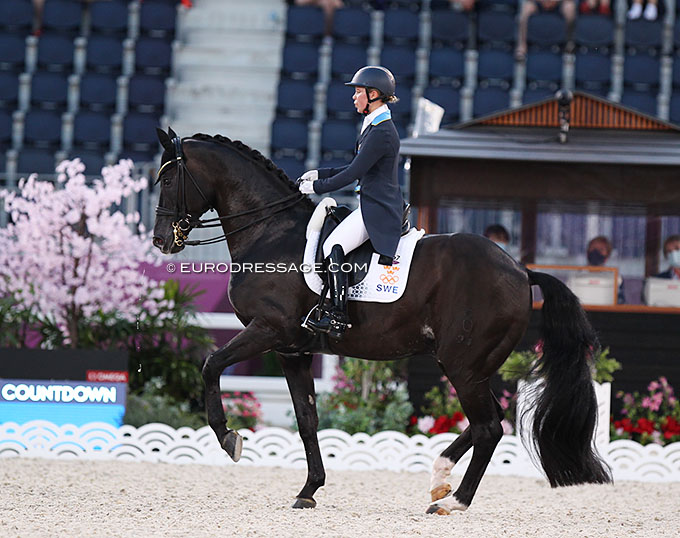
Quick Notes
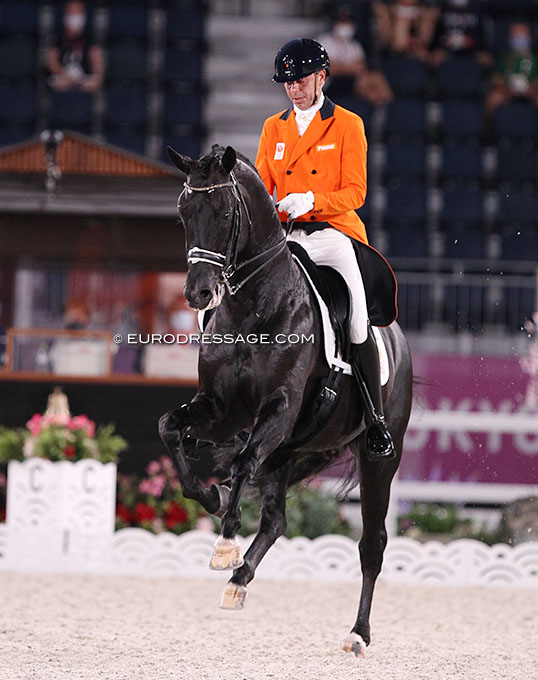
Carl Hester and his student Charlotte Dujardin's 12-year old Dutch warmblood En Vogue (by Jazz) posted 75.497% for a seventh place provisionally. The typical Jazz is not the easiest horse to ride but Hester truly showed once again what a great dressage master he is. He rides this horse with such focus and patience, the aids are minimal even though this horse definitely seems to need a bit of management to keep the lid on the cooker. The trot extensions were textbook although the right ground cover was achieved only after X. The horse is limited in overtrack in the extended walk and there was a mistake in the two's followed by a kick to the spur aid, as well as an unscripted change in the extended canter. The one tempi changes were dead straight and uphill the left pirouette was excellent, the right one a bit flat. Hester rode a careful final centerline. He posted 75.497%, a bit generous considering three big mistakes and a not so good walk, but it was a wonderful ride to watch nonetheless.
The Grand Prix continues today with the last three heats, after which we know which teams will move on to the Special and which individuals to the freestyle.
Text and Photos © Astrid Appels - No Reproduction Allowed!!
Related Link
Eurodressage Coverage of the 2021 Olympic Games